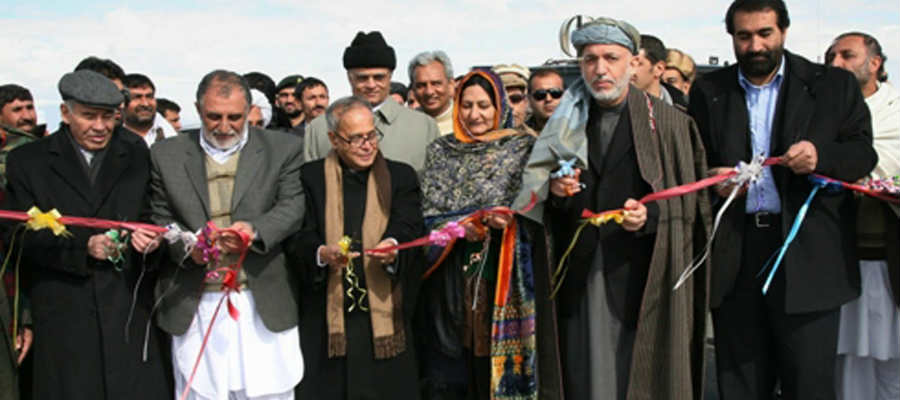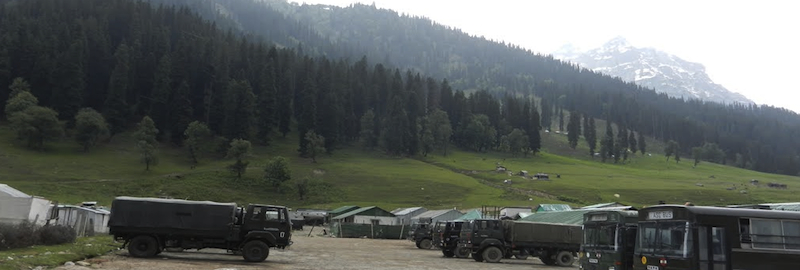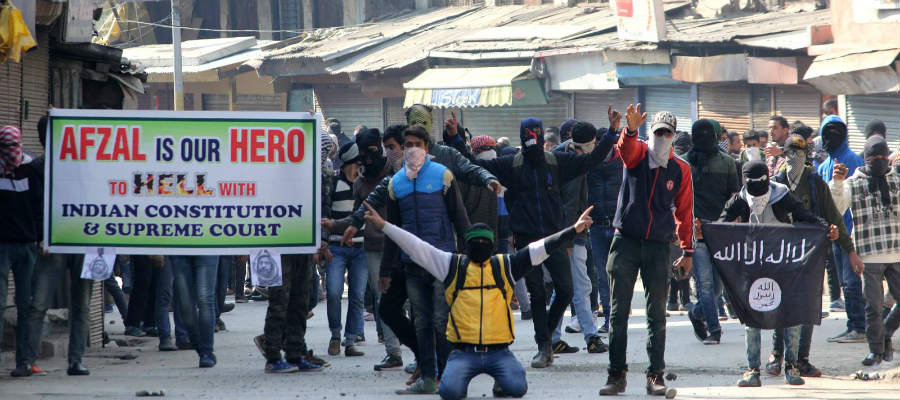BY VK SHASHIKUMAR
The Zaranj-Delaram highway in Afghanistan built by India and handed over to the Afghan government on January 22, 2009 is now under Taliban control. Within two years of the commissioning of this strategic highway, Taliban effectively dominates this road link, which has in turn allowed it to take control of the Nimroz province.
The Zaranj-Delarm road, on the main Herat-Kandahar Highway, constructed by thousands of Indian nationals in the face of stiff resistance from Taliban was meant to be one of most long lasting and visible symbols of India’s commitment to Afghanistan’s reconstruction and rebuilding of its nationhood.
But the unwillingness of the ISAF to provide security cover to this strategic highway and the inability of the Afghan National Army to secure Indian investments and projects has led to a colossal waste of Indian funds earmarked for Afghanistan’s development. India’s reluctance to commit troops on the ground to secure Indian development projects has led to the winding down of several projects that were received with tremendous enthusiasm by Afghans.
A Taliban press release dated January 15, 2011 clearly details Taliban’s control of the Nimroz province and, thereby, the Zaranj-Delaram Highway. This dry-desert province located in south eastern Afghanistan shares its borders with the Balouchistan province of Pakistan in the South and also shares its Western borders with Iran.
The Zaranj-Delaram highway links Nimroz’s provincial capital in Zaranj city to one of its districts, Delaram. The other districts are as follows—Chakhansor, Khashrod, Gank, Charbarjak. Currently, the de facto ruler of this province is Maulavi Abdul Rasheed. The Taliban describes him as the “head Jihadi military leader of Islamic Emirate of Afghanistan in charge of Nimroz province”.
The Taliban take-over of the ambitious Zaranj-Delaram road project, India’s plan of providing Afghanistan with a shorter route to the sea, via the Iranian port of Chabahar, has been derailed. The strategic importance of this road was to make Afghanistan current access to the sea coast through Pakistan commercially meaningless and irrelevant. On its part Iran is building a new transit route to connect its city of Milak to Zaranj in Afghanistan, and has already completed an important bridge over the Helmand River.
Once finished, the road projects in Iran and Afghanistan would have shortened the transit distance between Chabahar and Delaram by over 600 kilometres giving Afghan goods duty-free access to the Iranian port.
India, too, would have enjoyed similar benefits as Afghanistan at Chabahar port and for transit. But the forty year old Maulavi Rasheed, brought up in a Jihadi/Mujahid household in the Disho district of Helmand province, has successfully grounded the ambitious plans of the Indian policy makers.
The Maulvi studied Jihadi theology in a madrassa and was also trained as a terrorist learning weapon handling, fabricating IEDs and guerrilla warfare. Maulvi Rashid, a Balouch by birth, has taken part in Jihadi operations in Nimroz, Helmand, Kandahar, Kabul, Kapisa, Baghlan, Faryab and Kunduz provinces and has been wounded twice in Kapisa’s Koh-e-Safa and Faryab’s Khwaja Doko districts.
After the killing of his guru Maulavi Mahmood four years ago, Maulvi Rasheed took over as Taliban chief in Nimroz. In his January 2011 press release he described the Jihadi situation in the Nimroz province as follows: “Nimroz provincial capital along with all 5 districts have been covered by our Mujahideen groups who have been able to take complete control of Delaram and Khashrod districts but not the district centers.
Our Mujahideen are also carrying out regular guerilla attacks in Chakhansor and Gank districts and we are hopeful to Allah Almighty that he will also grant us a complete victory there soon.”
According to the Taliban the American troops have virtually vacated Nimroz province and are currently concentrated in the provincial headquarters in Delaram, which also has a small airfield. Besides this the US forces have an outpost in the Dahmazang area and a small contingent in the Zaranj city. They had an outpost in Khashrod’s Ghor Ghori area, which has been abandoned recently.
Ever since the Zaranj-Delaram road was commissioned in 2009, the American forces found it convenient to move men and material along this route. But with the Taliban taking control of this strategic highway, American military operations in Nimroz have been badly hit.
Maulvi Rasheed’s statement on the Taliban’s control of roads in the Nimroz province is as follows: “We have also been successful in closing logistical routes of the enemy (read United States) and in some areas have become an obstacle for them. The main road between Delaram and Khashrod has been closed for a very long time and Mujahideen also control many of the other roads. The Americans only dare to pass in huge convoys and only when accompanied by airpower.”
Taliban’s plan over the last two years seems to have been well thought out. While they withdrew and consolidated, they quietly allowed the reconstruction and rebuilding work to take places, especially in the road building sector. Except for some sporadic attacks on foreign road building crews, including couple of attacks on Indian road-builders, the Taliban seem to have allowed the road building activities to happen unhindered, especially in the south and south-west regions, which have been their traditional areas of strength in terms of their popular support base.
With the completion of the initial spurt of road building activities in the region, the Taliban effortlessly took over control and used these roads to rapidly deploy its guerrilla fighters. In fact, the Taliban has already established an “Islamic Emirate” in Delaram and Khashrod districts of Nimroz province and surrounding area by appointing the following officials–“Governor, District Deputy, Judge, Commission as well as heads for Education and Guidance.”
According to Maulvi Rasheed’s statement: “The people of Nimroz have embraced Mujahideen in recent years even more than before due to understanding the nature and false propaganda of democracy which the enemy spreads. The enemy is often trapped in their headquarters and when they do come out for an operation, they bomb the area and create an atmosphere of fear in hopes of achieving some progress. These types of enemy operations have caused immense damage to the lives and property of civilians in Nimroz, especially to the people of Khashrod district. The day to day achievements of Mujahideen of Islamic Emirate is related directly to the full support we garner from the people.”
In the context of these developments the long-term strategic objectives of New Delhi, Washington and Kabul must be severely scrutinised and questioned. What is the point of investing billions of dollars in the reconstruction of Afghanistan, if New Delhi and Washington cannot collaborate to protect the development related infrastructure? Also what’s the point of developing infrastructure that could be easily appropriated and used by the Taliban as has been embarrassingly revealed in the take-over of the Zaranj-Delaram Highway by the Taliban.
Several other Indian projects have quietly folded up in the face of threats by the Taliban. In fact, after the attack on the Indian Embassy in Kabul in 2008 the speed at which Indian projects are winding down clearly displays the Indian establishment fear of the Taliban. An Indian Classical Music Teaching project in Kabul supported by the Indian Council for Cultural Relations (ICCR) was shut down. This was a popular project amongst Afghan youngsters. Another project supported by the CII and headed by a former Indian army officer imparting various trade skills to Afghans was shut down after a Taliban threat.
Till 2009 the level of India’s assistance to Afghanistan had reached USD 750 million, making it the 5th largest bilateral donor after the US, UK, Japan and Germany. Given below are a list of projects that were initiated under Indian development assistance:
- Construction of a 220 KV Double Circuit Transmission Line from Pul-e-Khumri to Kabul and a 220/110/20 KV sub-station at Kabul under the North-East Power System project to bring power from neighbouring countries to Kabul (USD 111 million);
- Humanitarian food assistance of one million tons of wheat in the form of high protein biscuits distributed to 1.4 million schoolchildren every day under the School Feeding Programme, administered through the World Food Programme (USD 100 million);
- Construction of a 218 kilometre road from Zaranj to Delaram to facilitate movement of goods and commodities from Afghanistan to Iranian border (USD 175 million – approval for an additional USD 91 million is being sought);
- Reconstruction and completion of Salma Dam Power Project (42 MW) in Herat province (USD 116 million – approval for additional USD 36 million is being sought);
- Construction of Afghan Parliament (USD 83 million);
- Reconstruction of Indira Gandhi Institute of Child Health in Kabul in various phases, including reconstruction of surgical ward/polyclinic/diagnostic centre (USD 6.7 million);
- Reconstruction of Habibia School (USD 5.1 million);
- Digging of 26 tube wells in North West Afghanistan (USD 1.2 million);
- Gifting of vehicles (400 buses, 200 mini-buses, 105 municipality and 285 army vehicles) (USD 25 million);
- Setting up of 5 toilet-cum-public sanitation complexes in Kabul (USD 0.9 million);
- Telephone exchanges in 11 provinces connecting to Kabul (USD 11.1 million);
- Expansion of National TV network by providing an uplink from Kabul and downlinks in all 34 provincial capitals, contributing towards greater integration of the country (USD 6.8 million).
It is clear that Pakistani Army and its main covert agency, the Inter Services Intelligence (ISI) will continue to use the Taliban to destroy Indian footholds in Afghanistan. If India wants to capitalize on every rupee it invests in Afghanistan, then it must rethink its passive strategic posture to secure its humanitarian and development assistance. If India cannot and would not like to commit troops to protect its investments in Afghanistan, then it must stop all development assistance and infrastructure development because ultimately these projects will help Taliban consolidate and strengthen.
It is impossible to figure out why Indian strategic policy makers continue to make monumental mistakes, such as believing that Pakistan will allow India access to Afghanistan via a third country (Iran)!
It is impossible to believe that South Block and the PMO actually think it’s possible for India to by-pass checks posed by Pakistan in refusing to allow the transit of Indian goods en route to Afghanistan!
It is impossible to believe that New Delhi continues to be short-sighted and seems to have forgotten that Pakistan and its ally, Taliban, detests Indian reconstruction efforts in southern Afghanistan and in the Herat area bordering Iran. It is also important to remember that the Hamid Karzai government has virtually no control over these regions.
Given these realities on the ground India must rethink its strategy instead of falsely propagating its commitment to continue its development and reconstruction work in Afghanistan. The fact is that despite brave statements from New Delhi, India is actually diluting its presence and commitment in Afghanistan because Indian policy makers are afraid of deploying troops to protect its humanitarian and development initiatives funded by Indian tax payers.


